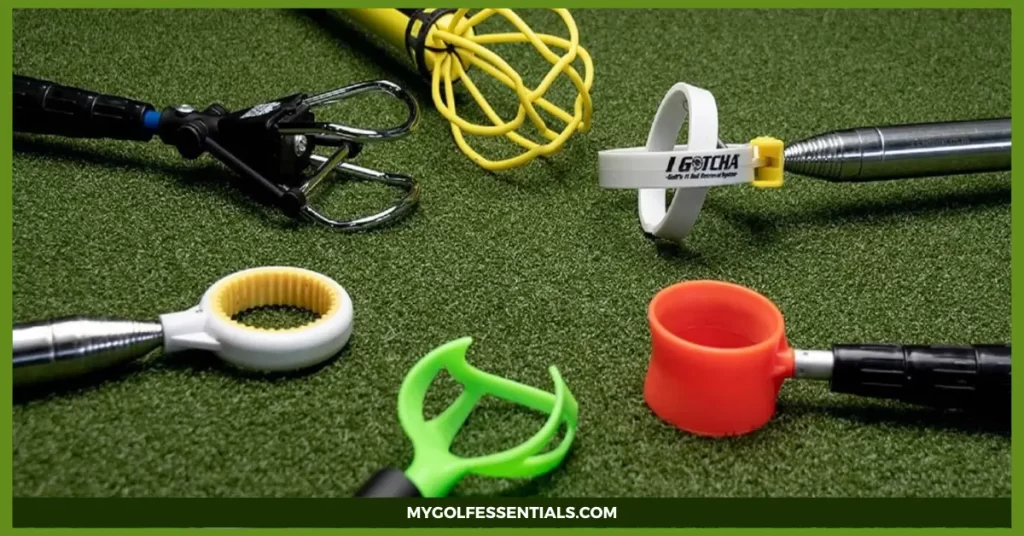
If you are new to the world of golf, it is easy to get frustrated or overwhelmed quickly. Why? Because there’s a sea of information available online. This can make it difficult to comb through what’s right, what’s not, and what’s optional. In this article, we act like your golf instructor and go through the golf swing tips every new golfer needs to know to overcome bad habits and how to improve your golf swing perfectly. The aim is to simplify the steps and give you a clear direction about what to focus on first.

Refine your Golf Grip and Posture
The most fundamental part of improving your golf swing is to improve your golf grip. If you fail to understand how to grip the golf club properly, you will have a hard time making decent shots. Start by choosing a golf club set like this one from Strata that is high-quality, easy to grip and comfortable to maneuver.
- Stand up straight with your shoulders back. Keep your arms relaxed, then hold the club at your waist. With your back straight, bend slightly until the golf club touches the grass. Put the weight on the balls of your feet and flex your knees with a little bend.
- Wear a pair of comfortable shoes, such as these Adidas Men’s Tech Response 2.0 Golf Shoes.
- Hold your golf club from the side rather than underneath. One way to control your hand movement towards the club is to stand in a golf posture and clasp your hands together.
- Place the golf club in your dominant hand in a way that the handle of the club runs from the bottom of your index finger to below your hand’s heel pad. When you place the club down on the ground, you should be able to see the top two knuckles on your dominant hand and the logo on the glove.
- Distribute your weight equally between the two feet. Make sure the bulk of the weight is mostly placed in the middle of the feet and not on your heels or toes.
- Keep the grip strength neutral; not too tight nor too loose. This means both thumbs should be placed on the club’s grip. Work on finding the right grip pressure that will enable you to swing your golf club freely while still controlling it.
Ensure Proper Alignment
One of the best swing tips you can receive is to fix your alignment. If your alignment is poor, you will have a very hard time hitting the ball consistently well. Pay more attention to the spine angle and position of your shoulders and hips than your feet. Aim the golf clubface to your target, your shoulders, and finally, your feet. The most fundamental aspects of getting into a solid setup position are your shoulder and clubface alignment.
Use Left Hand for Better Control
Once you have mastered your golf grip, use the back of your left hand to refine your open clubface and the direction of the shot. As a right-handed golfer, if you feel like your right hand is dominating the golf swing, it is best to stop it. Not only is this crucial in full swing, but also the short game. Allow your left hand to lead the way for both putting and chipping.

Use your Body for Power
Your body generates the most power when swinging your club. The motion always starts from putting your dominant foot down and generating power from the core in the body’s rotation.
- Place the club behind the ball, and keep your body in a dead-stop position.
- Drag the ball into the air without taking a backswing.
If you are a golfer who mainly uses their hands to control the club, you will initially have difficulty getting used to this. Follow this tip, and you will start to get the ball in the more easily.
Understand Weight Shift
Proper weight shift is an important part of a great swing. A key reason why so many amateur golfers struggle with correct weight transfer is that they sway a lot. This typically happens because people want to gain power, so they start bending forward and rocking back and forth to get their weight transferred through the ball. While the idea behind this is correct, the execution is normally not.
Swaying can make it more challenging to make solid contact with the ball. If your back shoulder moves more than a few inches, you should limit your movement while shifting your weight. A good tip is to not sway but instead rotate your body around.
Take your Sweet Time
It is easy to get carried away and rush the golf swing, but that probably does more harm than good. Allow your swing speed to develop gradually, with the clubs coming all the way down until it reaches impact.
Avoid Sliding
An important thing to remember when golfing is to not slide in either direction during the swing. Ideally, you should keep your body weight in the middle of the stance as you swing back. Balance is essential in golf; thus, staying away from all kinds of sliding motions will instantly improve your golf swing.
Turn – Shift – Turn
The turn-shift-turn is a simple technique you can use at home without a golf club to improve your swing.
- Start by placing your hands across your shoulders and stand in the correct golf posture. Look down over a golf ball (or an imaginary ball if you don’t have one available).
- Next, turn your backswing so that your back faces the target.
- Shift your weight to your left leg from the top of the backswing.
- Lastly, turn your body so your chest faces the target.
Doing this technique regularly will train your body regarding the right golf swing flow and thus allow you to do a perfect golf swing with real rhythm.

Pay Attention to Angles and Wrist Movement
Wrist angles play an important role in golfing. If you have poor wrist movement from the beginning of your swing, it can become difficult to recover later. It is important to start slow and then work your way up. Hit some balls in slow-motion while maintaining that wrist bend through impact and get a feel for the correct position. Assume a “backwards-K” position at impact and embed it into your muscle memory.
The next step is hitting punch shots while practicing your best golf swings. Your main focus should be maintaining the wrist angle through impact and not letting your left wrist swing too quickly. Once you’ve gotten enough practice and can consistently hit low-flight shots with your wrists bowed to a full swing, maintain the feeling of those correct angles.
Applying the same punch shot technique to your full swing will show more powerful and consistent ball striking.
Control your Temp
Many golfers struggle with control when swinging the club. This means either they swing too quickly or not quickly enough. A good tip to control your tempo is to start counting.
- Count to 1 when you begin your swing
- Count to 2 when you reach the top of your backswing
- Count to 3 at impact
- Count to 4 when reaching a balanced finish
Pick a Specific Target
One of the most important things you can do to perfect your golf swing is to pick a specific target for each shot you hit. Having a specific target in mind will allow you to stay committed to the swing at hand. Being indecisive can throw you off track and ruin the shot.
Regardless of the type of shot that you are trying to hit, it is best to have a target selected before taking your golf stance. Do not aim for the fairway; instead, pick out a specific target that you can see to monitor your swing.
As you perfect the art of choosing specific targets, you will gain more confidence behind your swings and feel like you have a higher margin for error.
See the Golf Club Hit the Golf Ball
This probably sounds like a no-brainer, but it is still a useful golf swing technique for new golfers. When swinging down through impact, make sure you can see the club hit the golf ball. Doing so will help you make solid contact, which is crucial for making good shots.
Keep your head down, as this will limit the movement of your arms and shoulders. Your shoulders should be able to turn through the ball on the way down, while your eyes should watch the ball the entire time.
Remain Still When Putting
It is important to keep your body completely still throughout the stroke. Unlike during a full swing, when you require plenty of help from the body to produce power and speed, putting calls for control and precision.
Rolling the ball toward the hole on the golf course hardly requires any effort, so you will want to focus on precisely controlling your stroke for a successful shot. One way to do so is to keep your body completely still while the putter swings. Ideally, you should move your shoulders to control the putter, while your hands and arms should go along naturally.
By letting your shoulders do the job, you can eliminate any room for unnecessary movement that normally sends putts off track. While you swing the putter, keep your head and torso still.
Stroke the Grass
One of the main issues that new golfers face while swinging is not having a consistent low point and the right driving range. When striking an iron, the low point should be after the ball. The best way to improve is by doing practice swings. Your goal should be to make the club hit the ground in the middle of the swing. Pay close attention to the noise made by the contact with the ground and keep repeating your motion. Once you’ve got the hang of it, choose a grass blade, draw a line, and try striking that spot.
Know your Golf Swing
A crucial tip to improve your golf swing is to know your swing. If you are always trying to change your distance and swing, getting comfortable over the ball can be a little difficult. Playing consistent golf comes from trusting your technique and sticking with it.
Build a simple and repeatable swing that gets the ball where you want. Don’t worry too much about perfecting what your swing looks like. Rather, pay attention to what works for you.
Establish a Pre-Shot Routine on the Golf Course
Your pre-shot routine happens before you grip the golf club. This is perhaps one of the most integral parts of playing consistent golf, yet many new and experienced overlook it. Having a pre-shot routine lets you:
- Set up a specific target
- Examine each shot and choose the right club
- Create an effective routine to minimize the jitters and play strategically and confidently
- Get familiarized with the holes and the golf course
The key is to create a pace for your pre-shot routine and maintain it from one round to the next. Here are some of the most important things to remember when setting up a pre-shot golf routine.
- Visualize the shot before hitting it.
- Focus on your angles and pay attention to where you want to start the ball
- Visualize the final shot
- Accept the outcome and move on; don’t let one bad shot ruin your own game
Play According to Your Strengths
Before you hit the ball on the golf course, you will be presented with a series of choices. What is your target selection going to be? Are you planning to hit the ball lower or higher than usual? These are just some of the questions that you need to answer while planning your stance. While working through this step, one of the main things to remember is your strengths and weaknesses as a golfer. You can accomplish the best results by staying away from your weaknesses and capitalizing on your strengths.
Nobody likes to admit they have weak areas in the game, but that is simply unrealistic. Don’t go for shots you can’t execute well just to prove a point. That doesn’t mean that you should give up and not improve in areas where you lack. As you practice, you will turn your weaknesses into strengths and no longer need to avoid your weak areas.
Final Thoughts
Improving your swing requires a lot of practice and patience. Now that you are aware of the best golf swing tips, it is time to start practicing to become a better golfer. Remember not to obsess about scoring the perfect golf swing, and don’t let a few bad shots get to you.



